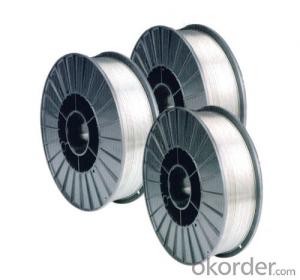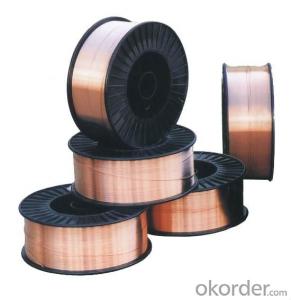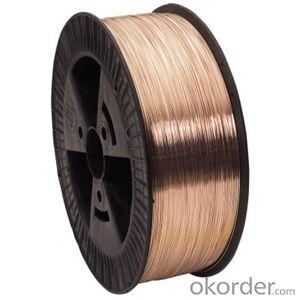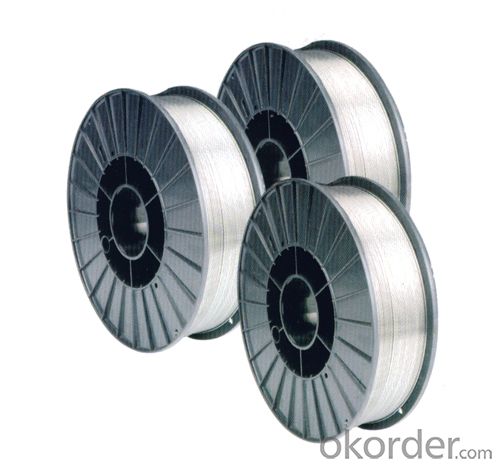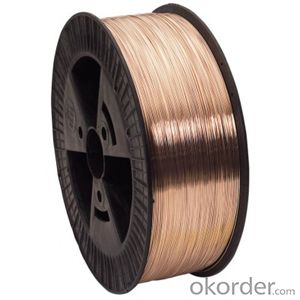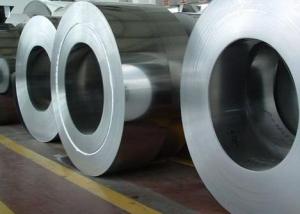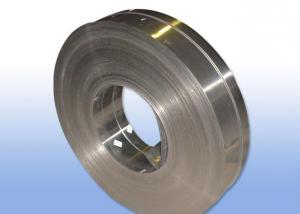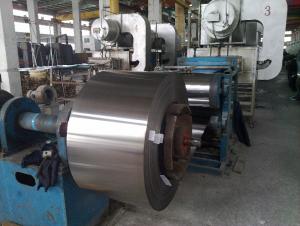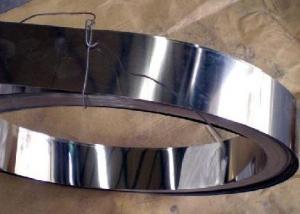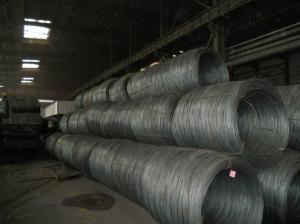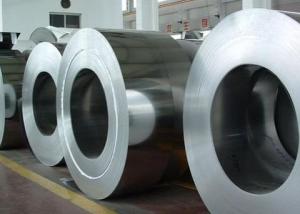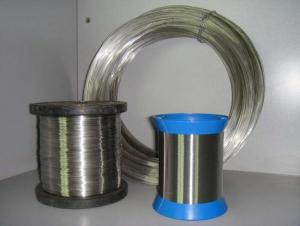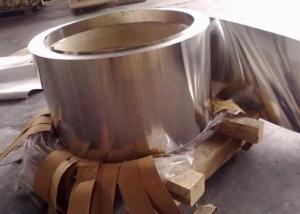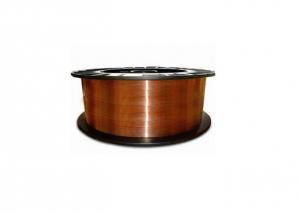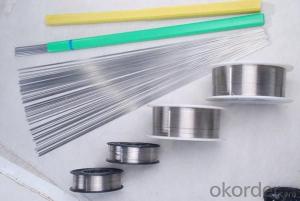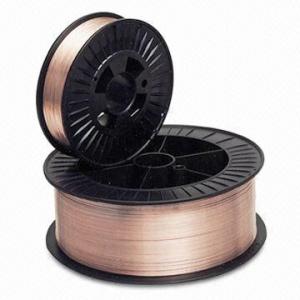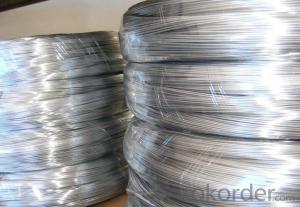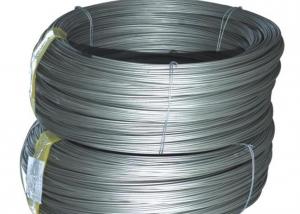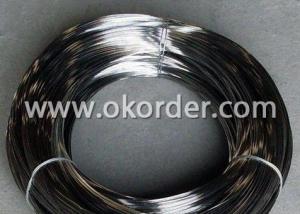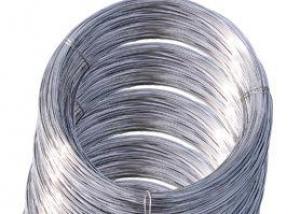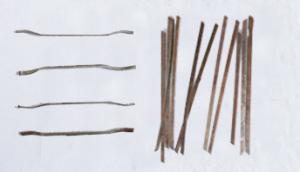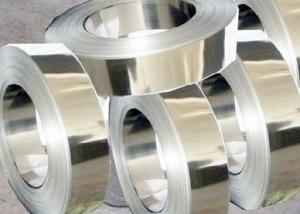Shiled Welding Wire AWS a5.18 er70s-6 co2 Gas
- Loading Port:
- Qingdao
- Payment Terms:
- TT or LC
- Min Order Qty:
- 10 m.t.
- Supply Capability:
- 1000 m.t./month
OKorder Service Pledge
OKorder Financial Service
You Might Also Like
Shiled Welding Wire AWS a5.18 er70s-6 co2 Gas
.Quick Information of Shiled Welding Wire
aws a5.18 er70s-6 co2 welding wire fil à souder has excellent mechanical performance such as depositing speed and high efficiency, stable arc, little splash, good welding seam.
This series of welding wires are suitable for the low carbon steel and low alloy structure, vehicle, bridge, container, construction machinery, boilers and construction etc.have depositing speed and high efficiency, stable arc, little splash, good welding seam.
Main Features of Shiled Welding Wire
1. very low welding cost, high productivity and low electricity consumption.
2. excellent welding performance, stable arc, low spatter, easy slag removal.
3. perfect welding seam forming, small weld metal stomatal sensitivity.
4. easy operating, all position welding.
5. very low hydrogen content in the weld and lower nitrogen content, excellent crack-resistance.
6. little deformation after welding.
7. wide applicability. suitable for welding thin, medium and thick plates.
8. Suitably wide range of welding current.
ER70S-6 Welding Wire for Low Carbon Steel Weld has been widely used in all kind of field. such as automotive industries, construction machinery production, shipbuilding, metallurgical equipment production, bridges, civil works, petrochemical industry, pressure vessels of boiler, locomotives, etc.
Specification
Wire Size | Spool Size | Package Size |
0.8mm 1.0mm | D100mm D200mm D300mm K300mm | 1kg 5kg 15kg 20kg 250kg 350kg |
C | Mn | Si | S | P | Cu | Other | |
standard value | 0.06-0.15 | 1.40-1.85 | 0.80-1.15 | ≤0.035 | ≤ 0.025 | ≤ 0.50 | ≤ 0.50 |
sample value | 0.08 | 1.51 | 0.92 | 0.020 | 0.016 | 0.20 | 0.02 |
Typical Mechanical Properties of Deposited Metal:
Tenile strength δb (MPa) | Yield Point δ0.2(MPa) | Elongation δ5 (%) | AKV Impact Value (J) (-20°C) | Shielding Gas |
≥ 500 | ≥ 420 | ≥ 22 | ≥ 27 | 100%CO2 |
560 | 500 | 27 | 102 | 100%CO2 |
Diameter of Wire & Reference Current (DC+):
Diameter of wire (mm) | Ø0.8 | Ø 1.0 | Ø 1.2 | Ø 1.6 |
F current (A) | 40-180 | 50-220 | 80-350 | 170-550 |
V current (A) | 40-140 | 50-160 | 50-180 | |
OH current (A) | 40-120 | 50-160 | 45-180 |
FAQ:
Q:How about your quality?
A:Our products are manufactured strictly according to national and international standard, and we take a test on every pipe before delivered out. If you wantto see our quality certifications and all kinds of testing report, please just ask us for it.
Picture:
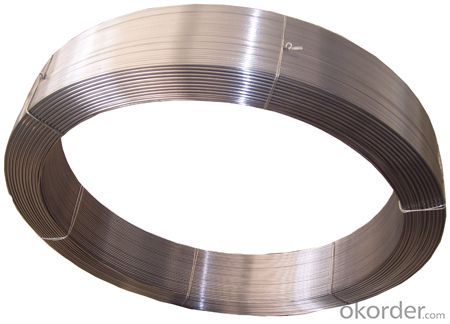
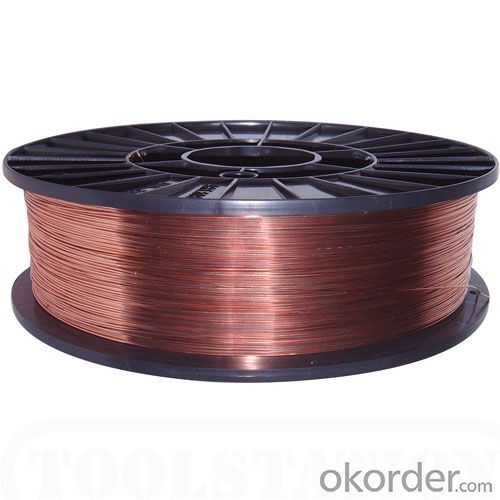
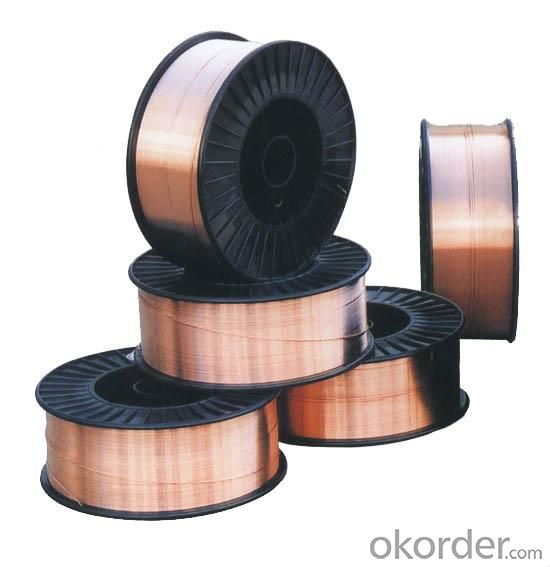
- Q: What are the common uses of stainless steel wire in the chemical industry?
- The chemical industry extensively utilizes stainless steel wire, thanks to its exceptional properties and versatility. Consequently, stainless steel wire finds various applications in this industry, including: 1. Filtration: In chemical processes, stainless steel wire mesh is commonly employed as a filtration medium. It proficiently eliminates impurities and particles from liquids and gases, thereby ensuring the purity of the end product. The corrosion-resistant nature of stainless steel renders it perfect for this purpose. 2. Conveying and handling corrosive substances: To handle, lift, and transport corrosive chemicals and materials, stainless steel wire ropes are frequently employed. They exhibit resistance to corrosion, abrasion, and high temperatures, thereby making them suitable for harsh environments. 3. Support structures: Stainless steel wire ropes and cables often serve as support structures for heavy equipment and structures in chemical plants. They provide strength, durability, and corrosion resistance, thereby guaranteeing the safety and stability of the installations. 4. Heat exchangers: In many chemical processes, stainless steel wire is used in the construction of heat exchangers, which play a crucial role. The high heat conductivity of stainless steel enables efficient heat transfer while resisting corrosion, thereby ensuring the longevity and dependability of the equipment. 5. Reactor vessels and storage tanks: Due to its excellent corrosion resistance, stainless steel wire is frequently utilized in the fabrication of reactor vessels and storage tanks. It can endure exposure to a wide range of chemicals while maintaining the integrity of the containment system. 6. Instrumentation and control systems: Various instruments and control systems in the chemical industry incorporate stainless steel wire in their construction. This is because stainless steel wire possesses high electrical conductivity and corrosion resistance, making it suitable for wiring, connectors, and circuitry components. All in all, stainless steel wire is an essential material in the chemical industry due to its corrosion resistance, high strength, and exceptional performance in demanding environments. Its applications span from filtration and conveying to structural support, heat exchange, and instrumentation, making it an indispensable resource in chemical processes.
- Q: Is stainless steel wire resistant to atmospheric corrosion?
- Yes, stainless steel wire is resistant to atmospheric corrosion. Stainless steel is specifically designed to be resistant to corrosion in various environments, including atmospheric conditions. This is due to the presence of chromium, which forms a protective layer on the surface of the stainless steel wire, preventing the penetration of corrosive elements from the atmosphere. This protective layer, known as the passive film, acts as a barrier between the stainless steel and the corrosive agents, such as moisture, oxygen, and pollutants in the air. As a result, stainless steel wire can withstand exposure to atmospheric conditions without experiencing significant corrosion or degradation. This makes stainless steel wire a popular choice for various applications, including outdoor structures, marine environments, and industrial settings where exposure to the atmosphere is a concern.
- Q: 304 stainless steel wire drawing why rust?? long rust what is the reason?
- The machined stainless steel has a change in the composition and structure of the machined surface, and the corrosion resistance will be reduced and the rust will be easily rusted.
- Q: Can stainless steel wire be used for springs in watches?
- Yes, stainless steel wire can be used for springs in watches. Stainless steel is a popular choice for watch springs due to its excellent corrosion resistance, durability, and ability to maintain its shape and elasticity over time.
- Q: Can stainless steel wire be used for springs in the energy industry?
- Springs in the energy industry can indeed utilize stainless steel wire. This material, known for its versatility and durability, boasts remarkable resistance to corrosion and impressive strength. Due to these qualities, springs crafted from stainless steel wire can withstand extreme temperatures and harsh surroundings, making them ideal for a wide range of applications in the energy sector. These springs find utility in various equipment and machinery involved in energy generation, transmission, and storage, including turbines, generators, compressors, and pressure vessels. Thanks to the robustness of stainless steel wire, these springs maintain their shape and offer reliable performance even under heavy loads and high stress conditions. Furthermore, the corrosion resistance of stainless steel ensures the longevity and dependability of these springs, even in the corrosive environments that are commonly encountered in the energy industry. Consequently, due to its strength, durability, and corrosion resistance properties, stainless steel wire emerges as a fitting choice for springs in the energy sector.
- Q: Can stainless steel wire be used in high temperature environments?
- Indeed, high temperature environments can accommodate the use of stainless steel wire. Renowned for its exceptional heat resistance properties, stainless steel proves to be a fitting choice for situations that involve elevated temperatures. Its capacity to endure extreme temperatures without compromising its strength or integrity is attributed to its high melting point. Consequently, stainless steel wire emerges as an optimal solution for industries such as aerospace, automotive, and manufacturing, where components face exposure to heightened temperatures. Moreover, the exceptional corrosion resistance of stainless steel wire further enhances its aptitude for high temperature environments.
- Q: What are the different types of stainless steel wire rope swivels?
- There is a wide range of stainless steel wire rope swivels available in the market. Here are some options to consider: 1. Single Ball Bearing Swivels: These swivels are designed with a single ball bearing, enabling smooth rotation and reduced friction. They are commonly used when expecting moderate to high loads. 2. Double Ball Bearing Swivels: For increased load capacity and improved rotation, double ball bearing swivels are the ideal choice. They provide exceptional strength and durability, making them suitable for heavy-duty applications. 3. Barrel Swivels: Designed in a cylindrical shape, barrel swivels are commonly used in fishing. Their purpose is to prevent twisting or tangling of fishing lines while allowing for smooth rotation. 4. Clevis Swivels: Clevis swivels are equipped with a clevis pin, enabling easy attachment and detachment of the swivel. They are widely used in lifting and rigging applications where quick and secure connections are crucial. 5. Eye & Eye Swivels: These swivels have loops on both ends, making it easy to attach them to other rigging components. They are commonly used in overhead lifting applications and can accommodate multiple connections. 6. Bolt Snap Swivels: Bolt snap swivels have a spring-loaded snap hook that ensures quick and secure attachment. They are often utilized in marine applications, such as connecting ropes or chains to anchors or buoys. When selecting a stainless steel wire rope swivel, it is vital to consider the specific requirements of your application. Factors such as load capacity, rotational movement, and attachment method should be carefully evaluated to ensure that the chosen swivel effectively meets your needs.
- Q: What are the different types of stainless steel wire mesh weaves?
- There are several different types of stainless steel wire mesh weaves, each designed for specific applications and purposes. Some of the most common types include: 1. Plain weave: This is the most basic and commonly used weave pattern, characterized by an equal number of warp and weft wires that are tightly woven together. It provides good strength and durability while maintaining a smooth surface. 2. Twill weave: In this weave pattern, each weft wire passes alternatively over and under two warp wires, creating a diagonal pattern. Twill weave offers better stability and strength compared to plain weave, making it suitable for heavy-duty applications. 3. Dutch weave: This weave pattern is characterized by a higher density of warp wires compared to weft wires. It creates a tight mesh with smaller openings, making it ideal for applications that require fine filtration or separation of particles. 4. Twilled Dutch weave: This weave pattern combines the characteristics of twill weave and Dutch weave. It has a double layer of weft wires that are woven in a twill pattern, resulting in a robust and highly stable mesh with excellent filtration capabilities. 5. Reverse Dutch weave: Unlike Dutch weave, the reverse Dutch weave has smaller warp wires and larger weft wires. This weave pattern provides high strength and durability, making it suitable for heavy-duty applications such as filters and conveyor belts. 6. Five-heddle weave: This weave pattern is characterized by a uniform and symmetrical arrangement of warp and weft wires. It offers good stability and high tensile strength, making it suitable for various industrial applications. These are just a few examples of the different types of stainless steel wire mesh weaves available. The choice of weave pattern depends on the specific requirements of the application, such as filtration needs, strength requirements, and surface smoothness.
- Q: Is stainless steel wire suitable for wire rope thimbles?
- Yes, stainless steel wire is suitable for wire rope thimbles. Stainless steel is known for its corrosion resistance and durability, making it an excellent choice for applications where the wire rope thimble will be exposed to harsh environments or moisture. Stainless steel wire rope thimbles provide added strength and protection to wire ropes, ensuring that they maintain their structural integrity and prevent wear and damage. Additionally, stainless steel wire rope thimbles are often used in marine, industrial, and outdoor applications due to their ability to withstand high loads and resist rust and corrosion.
- Q: Can stainless steel wire be used for making wire forms?
- Yes, stainless steel wire can be used for making wire forms. Stainless steel is a versatile and durable material that is commonly used in various applications, including wire forming. Its corrosion resistance, strength, and flexibility make it suitable for creating intricate wire shapes and forms.
Send your message to us
Shiled Welding Wire AWS a5.18 er70s-6 co2 Gas
- Loading Port:
- Qingdao
- Payment Terms:
- TT or LC
- Min Order Qty:
- 10 m.t.
- Supply Capability:
- 1000 m.t./month
OKorder Service Pledge
OKorder Financial Service
Similar products
Hot products
Hot Searches
Related keywords
